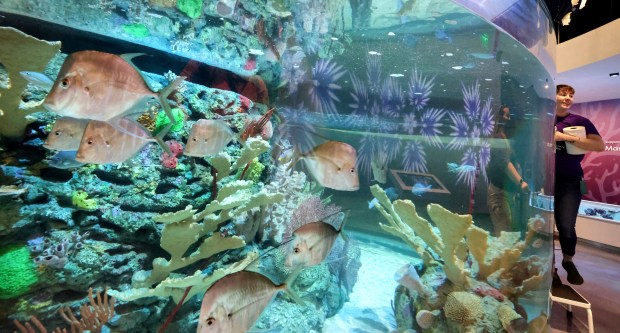Izzy, the two-toed sloth, has just been hanging around these days in her home, the new “Life” exhibit at Orlando Science Center.
She has trees to climb, a rope from which to dangle and a hammock for regular relaxing.
Science center visitors will get a good look at Izzy and other animal inhabitants of “Life” after it opens to the public on Thursday. The nature exhibit encourages close encounters in three ecosystems: rainforest, swamp, and ocean.
At 10,000 square feet, “Life” is the largest exhibit ever created by the museum, and it comes with a $13.5 million price tag. It replaces “Natureworks,” which closed in 2022.
The rainforest section of “Life” is two stories high and home to Izzy, tortoises, birds, fish and tamarins, who can roam and fly freely among the trees if they desire. There are designated feeding areas – keeping the monkeys out of the bird food – and backstage sleeping areas as options.
“This isn’t a display. It’s their home, and you’re a guest in their home,” said Jeff Stanford, vice president of marketing. “That’s all to create a very intimate connection between the visitor and our animals.”
Izzy has made herself comfortable for a few weeks before the opening, nibbling on zucchini, cucumbers and other plant materials. She climbs. She naps.
“She is loving her new home. She is very active out here,” said Shannon Zimmerman, curator of conservation and welfare.
The animals, even the fish, have been transitioning into the living space after quarantine periods.

But they’re an active bunch. Visitors may catch the two Prevost’s squirrels, who are sisters, scampering through overhead tunnels in the swamp section, where there are also a pair of burrowing owls, who just might become love birds one day. It feels like you could reach out and touch one, but that’s not the purpose of “Life.”
“We’ll be doing programs on microphones for guests, doing training sessions, talking about the status in the wild,” Zimmerman said. “But we won’t be handing a sloth off to you in this space.”

More tortoises and alligators are found beneath the cypress trees that have been a centerpiece of the museum for decades. With the remodeling, people can get physically closer to the water and its inhabitants.
“When the building opened in 1997, there was a different ideology around exhibit design than there is now. … I think museums have evolved to be more of an experiential space and be less about production design or setting and more about what is happening in that space,” Stanford said.
“We wanted the exhibit to be inclusive and to be very visual, and then also open it up,” he said.
In the ocean section, a young Bonnethead shark circles the tank amid an array of fish, including tang, grunts, parrotfish and other species seen in Florida.

An opportunity to get hands-on is with the nearby underwater exhibit, stocked with animals that can be found in Indian River Lagoon, such as slipper lobsters, horseshoe crabs, pin cushion urchins and sea stars.
Visitors will also be exposed to a rotating lineup of “animal ambassadors,” ranging from a possum to a Burmese python.
Digital displays help explain which species are which and some environmental issues.
Orange County steered $10 million from tourist development taxes to the exhibit, and Sarah Layton, a corporate consultant and philanthropist, donated $3 million to the project. She has a “presenting sponsor” credit in the exhibit. Layton’s gift is the largest individual contribution in the history of the science center.
The new space is bright, green and obvious on the approach from the science center’s parking garage. From the end of the overpass, folks can look down into “Life,” a nice perch for animal watching.
“One thing about an animal exhibit is sometimes you can walk in there, and you’re really searching for them. They’re hiding there. They’re back in the bushes or in the foliage somewhere,” said JoAnn Newman, CEO and president of the science center.
The view from up top was a “very intentional part of it. And it also, I think, added to the beauty of it and gives you that feel as you walk across that bridge … something’s changed,” she said.

“Life” is more focused than its predecessor, Newman said.
“We really tried to hone in on three important habitats that really gives us this foundation from which we can tell any story about the planet, animals, the environment, climate,” she said. “It just gives us such a great launching point.”
Email me at [email protected]. Threads account: @dbevil. X account: @themeparks. Subscribe to the Theme Park Rangers newsletter at orlandosentinel.com/newsletters.
